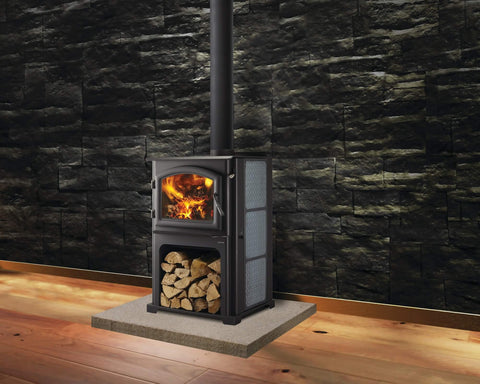Watching the glow of a fire through clean glass is one of the best parts of owning a wood stove. But when your view disappears behind soot, it’s frustrating and messy. If you’ve ever wondered how to keep wood stove glass from getting black, you’re not alone. This guide explains why it happens, how to prevent it, and the best ways to keep your wood stove glass clean all season long.
Explore Wood Stoves and the Find A Dealer page.
Why Does My Pellet Stove Glass Turn Black?
If you’re asking, “Why does my pellet stove glass turn black?” the answer comes down to creosote buildup, a residue formed when smoke cools and sticks to surfaces inside your stove. The cooler the glass, the more likely soot will cling to it.
Using wood with too much moisture also creates extra smoke, increasing creosote. Wet logs release vapor and tar that settle on glass instead of venting through the chimney. Poor airflow or a weak draft makes this problem worse, trapping smoke and staining the surface faster.
To prevent soot buildup on wood stove glass, make sure you’re burning dry, seasoned wood and maintaining proper airflow through your stove and chimney.
See more in our Preparing Your Stove or Fireplace for the Summer Months blog.
How to Keep Wood Stove Glass from Getting Black
The best way to prevent black glass is by improving the burn. Here’s how to keep soot from ever forming on the glass.
Invest in the Right Size Stove
A stove that’s too large for your space often burns cooler, causing incomplete combustion and faster creosote buildup. Running your stove at medium to medium-high output during the day keeps temperatures high enough for a clean burn.
Properly Install a Chimney
A well-maintained chimney ensures proper draft. Poor draft traps smoke inside the stove, which leads to blackened glass.
Make sure your chimney meets recommended height requirements, is properly insulated, and stays clean. Regular cleaning also removes soot and creosote that can block airflow and lead to smoky fires.
Use Dry, Seasoned Wood
Moisture is one of the biggest culprits behind dirty glass. Burning wood with a moisture content between 18–20% keeps fires hotter and cleaner. You can check levels with a moisture meter or look for signs like cracks at the ends and light weight.
If your logs hiss, steam or bubble when burning, they’re too wet. Properly seasoned wood prevents soot buildup and ensures your stove runs efficiently.
Read more in our Wood Stove Maintenance Tips by Week, Month, and Year blog.
How to Keep Wood Stove Glass Clean
Even with careful burning, some residue is inevitable. The key is cleaning regularly so soot never hardens. Start only when the stove is completely cool. Use a soft, damp cloth dipped in cool ash to gently scrub away buildup.
For a deeper clean, mix vinegar and water or use a non-abrasive stove glass cleaner. The more frequently you wipe your glass, the easier it becomes to maintain clarity.
Consistent maintenance keeps your stove performing and looking its best.

Contact a Dealer to Get the Best Forge & Flame Wood Stove for Your Home
A clear view of your fire starts with a clean burn. By using dry wood, maintaining airflow and cleaning regularly, you can prevent soot buildup on wood stove glass.
Forge & Flame wood stoves are engineered with precision airflow systems and durable cast iron to reduce soot naturally and keep your fire burning bright.
Ready to upgrade your stove experience?
Browse Forge & Flame Wood Stoves or Find a Dealer Near You.


